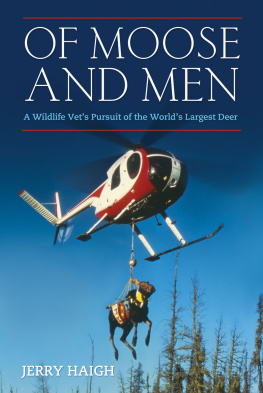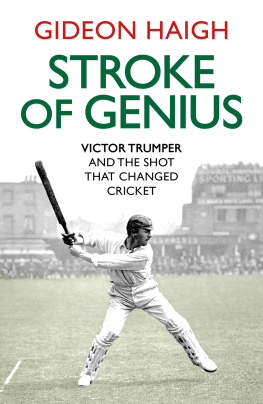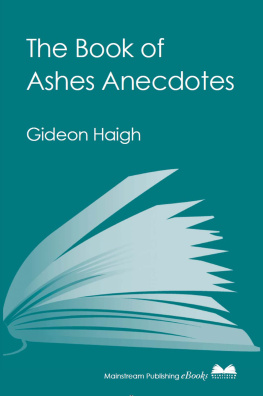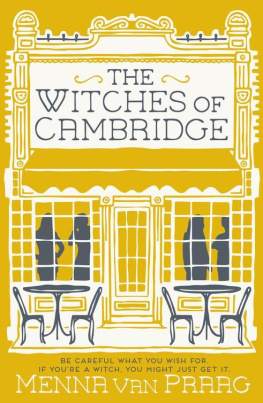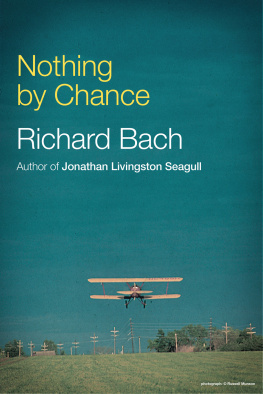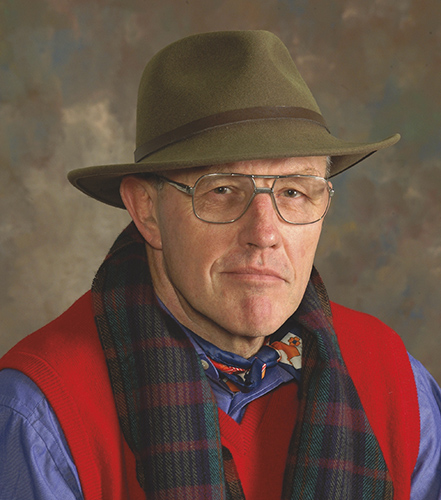Dr. Jerry Haigh is a Kenya-born, Glasgow graduate veterinarian whose career-long experience with wildlife has spanned four decades and four continents. He has worked on species ranging from elephants to wild dogs and polar bears to moose. He is the author of The Trouble with Lions: A Glasgow Vet in Africa (2008) and Wrestling with Rhinos: The Adventures of a Glasgow Vet in Kenya (2002). He lives near Saskatoon with Joanne, his wife of forty-three years, and an old Labrador named Caesar.
A charmingly unrestrained narrator presents chapter subtitles like More matters moosey, offering a hodgepodge of information about the behemoth of the family Cervidae. From the historical to the biological, Haigh leaves no aspect of moose-bound lore uncovered.
This is a very easy-to-read book which can be picked up and dipped into during coffee breaks but beware, the coffee breaks may become longer than intended.
Haighs writing style is informative and entertaining all in the same breath. His stories weave animal history and legend together with his own experiences to create a vivid picture of the wildlife situation in Africa.
It is not real work unless you would rather be doing something else.
ACKNOWLEDGEMENTS
I offer a special vote of thanks to Vince Crichton, who is the senior moose biologist working in Canada today. He received the Distinguished Moose Biologist Award in 1988 and was elected president of the North American Moose Foundation in 2005. He not only wrote the foreword to this work but also commented on some important issues and generously allowed the use of some of his photographs.
Elder Barry Ahenakew generously shared both history and words about moose from the Cree perspective, and Darryl Chamekese of the Saskatchewan Indian Cultural Centre was an invaluable resource and shared personal stories about moose.
Special thanks also to those who read and commented on whole chapters, set me right on important facts, and allowed me to use some of their wonderful photos and artwork: George Bubenik, Ken Child, Kris Hundertmark, Tom Knight, Andrzej Krzywinski, Susan Kutz, Mats Lindquist, Adrian Lister, Richard McCabe, Alexander Minaev, Jane Mingay, Nigel Monaghan, Milla Niemi, Jessica Paterson, Bill Samuel, Julia Sigwart, Bob Stewart, Gerhard Stuewe, Jimmy Suttie, Ken Tustin, Nicholas Tyler, Victor van Ballenberghe, and Murray Woodbury.
In order to do as thorough job as possible, one of my self-imposed tasks was to try and gain an understanding of the status of moose in the early twenty-first century, and to that end I contacted biologists from just about every range country, U.S. state, and Canadian province where moose exist. I read as many volumes as I could of the Proceedings of the North American Moose Workshop, not just the publications from the workshops I was lucky enough to attend. These workshop proceedings morphed into the journal Alces, whose front-cover mandate reads: A Journal Devoted to The Biology and Management of Moose. I owe the contributors and editors sincere thanks for their hard work. I also consulted several books that contained useful information. When those attempts failed, I went, with some care, to the Internet. In the end I was able to obtain information on fifty-five regionsincluding five separate ones in Russia, which I think is excusable because there are nine time zones involved.
I made several calls to colleagues whom I had met at various moose conferences over the years and had help from numerous biologists whom I have never met. Apart from those named above, others who replied to my queries and sent me valuable information that I could not have obtained from books and journals were: Gundega Aizupiete, James Allen, Anis Aoude, Jon Arnemo, Jim Baker, Linas Balciauskas, Kimberlee Beckmen, Roger Bergstrm, Dean Beyer, John Blake, Erika Butler, Nigel Caulkett, Terry Chapin, Kjell Danell, Pjotr Danilov, Mark Drew, John Fletcher, Brett Elkin, Sunne Hggmark, Doug Heard, Yeen Ten Hwang, Bill Jensen, Jon Jorgensen, Doug Jury, Lee Kantar, Kalin Kellie, Steve Kilpatrick, Sbastian Lefort, Anders Lie, Ray Longmuir, Christopher Lyons, Peter Macdonald, Colin Mackintosh, Rick Marshall, Don McInnes, Tuire Nygrn, Danila Panchenko, Bob Patenaude, Brent Patterson, Rolf Peterson, Memoree Philipp, Margot Pybus, Mike Ramsay, Jim Rettie, Bengt Roken, Christine Ruggere, Dwayne Sabine, Steve Schmitt, Helen Schwantje, Karen Simonson, Christopher Smith, Norman D. Smith, Sharon Snowshoe, Erling Solberg, Sarah Spencer, Rob Tether, Raisa Tillikainen, Dale Toweill, and Randy Wright.
Past and present members of my writers group gave me much valuable feedback. They are Wilfred Bird, George Bitz, Eve Kotyk, Kurt van Kuren, Rebecca Lloyd, Judy McCrosky, Bobbi Mumm, Gayle Smith, and Jon Watts.
This work would not have been possible without the dedication and patience of my wife, Joanne, who read and re-read every word and made many useful suggestions.
Finally, my editors. Meaghan Craven kept an eagle eye on everything and made invaluable contributions to the entire enterprise. Jen Knoch of ECW Press tidied up the loose ends, organized the layout and photos and made important suggestions.
Credit goes to all of these generous people, but errors and omissions are entirely my own responsibility.
FOREWORD
Storytelling comes alive in this book by Jerry Haigh, the Glasgow veterinarian who documents his travels from Scotland via Africa to Saskatchewan.
Linking education and the future of moose presents a formidable challenge to wildlife managers and biologists. This retired Glasgow vet does a service toward this end by touching on many fascinating aspects of this boreal forest icon by giving the reader a glance into many aspects of moose biology and management a vital task, since an informed public is essential for its future.

